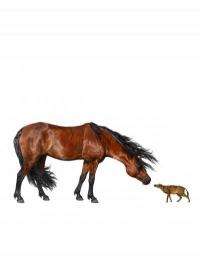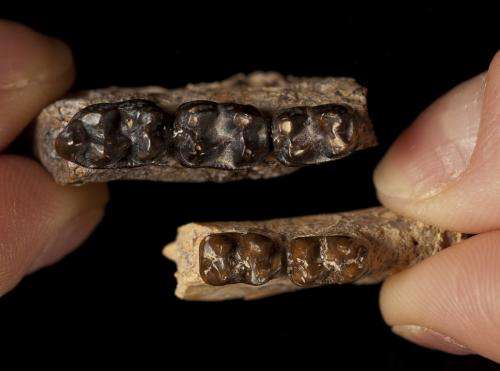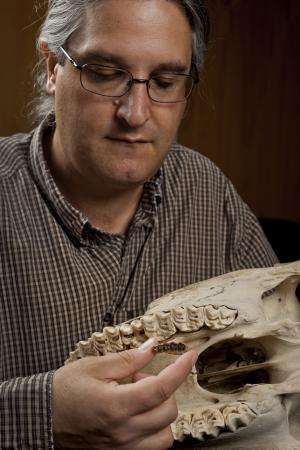Research reveals evolution of earliest horses was driven by climate change, global warming affected body size

When Sifrhippus, the earliest known horse, first appeared in the forests of North America more than 50 million years ago, it would not have been mistaken for a Clydesdale. It weighed in at around 12 pounds -- and it was destined to get much smaller over the ensuing millennia.
Sifrhippus lived during the Paleocene-Eocene Thermal Maximum, a 175,000-year interval of time some 56 million years ago in which average global temperatures rose by about 10 degrees Fahrenheit, caused by the release of vast amounts of carbon into the atmosphere and oceans.
About a third of mammal species responded with significant reduction in size during the PETM, some by as much as one-half. Sifrhippus shrank by about 30 percent to the size of a small house cat (about 8.5 pounds) in the PETM's first 130,000 years and then rebounded to about 15 pounds in the final 45,000 years of the PETM.
Scientists have assumed that rising temperatures or high concentrations of carbon dioxide primarily caused the phenomenon in mammals during this period, and new research led by Ross Secord of the University of Nebraska-Lincoln and Jonathan Bloch of the Florida Museum of Natural History at the University of Florida in Gainesville offers new evidence of the cause-and-effect relationship between temperature and body size. Their findings also offer clues to what might happen to animals in the near future from global warming.
In a paper to be published in the Feb. 24 issue of the international journal Science, Secord, Bloch and colleagues used measurements and geochemical composition of fossil mammal teeth to document a progressive decrease in Sifrhippus' body size that correlates very closely to temperature change over a 130,000-year span.
Bloch, associate curator of vertebrate paleontology at the Florida Museum of Natural History, said multiple trails led to the discovery.

One was the fossils themselves, recovered from the Cabin Fork area of the southern Bighorn Basin near Worland, Wyo. Stephen Chester, then an undergraduate student at Florida, now an anthropology Ph.D. candidate at Yale and a co-author on the paper, had the task of measuring the horses' teeth. What he found when he plotted them through time caught Bloch and Secord by surprise.
"He pointed out that the first horses in the section were much larger than those later on," Bloch recalled. "I thought something had to be wrong, but he was right -- and the pattern became more robust as we collected more fossils."
A postdoctoral researcher in Bloch's lab for the first year of the project, Secord performed the geochemical analysis of the oxygen isotopes in the teeth. What he found provided an even bigger surprise.
"It was absolutely startling when Ross pulled up the first oxygen isotope data," Bloch said. "We looked at the curve and we realized that it was exactly the same pattern that we were seeing with the horse body size.
"For the first time, going back into deep time -- going back tens of millions of years -- we were able to show that indeed temperature was causing essentially a one-to-one shift in body size within this lineage of horse. Because it's over a long enough time, you can argue very strongly that what you're looking at is natural selection and evolution -- that it's actually corresponding to the shift in temperature and driving the evolution of these horses."

Secord, who came to UNL in 2008 as an assistant professor of Earth and atmospheric sciences and curator of vertebrate paleontology at the University of Nebraska State Museum, said the finding raises important questions about how plants and animals will respond to rapid change in the not-too-distant future.
"This has implications, potentially, for what we might expect to see over the next century or two, at least with some of the climate models that are predicting that we will see warming of as much as 4 degrees Centigrade (7 degrees Fahrenheit) over the next 100 years," he said.
Those predictions are based largely on the 40 percent increase of atmospheric carbon dioxide levels (from 280 to 392 parts per million) since the start of the Industrial Revolution in the mid-19th century.
Ornithologists, Secord said, have already started to notice that there may be a decrease in body size among birds.
"One of the issues here is that warming (during the PETM) happened much slower, over 10,000 to 20,000 years to get 10 degrees hotter, whereas now we're expecting it to happen over a century or two," Secord said. "So there's a big difference in scale and one of the questions is, 'Are we going to see the same kind of response?' Are animals going to be able to keep up and readjust their body sizes over the next couple of centuries?"
Increased temperatures are not the only change animals will have to adapt to, Secord said. Greenhouse experiments show that increased atmospheric carbon dioxide lowers the nutritional content of plants, which he said could have been a secondary driver of dwarfism during the PETM.
More information: "Evolution of the Earliest Horses Driven by Climate Change in the Paleocene-Eocene Thermal Maximum," Science (2012).
Journal information: Science
Provided by University of Nebraska-Lincoln

















